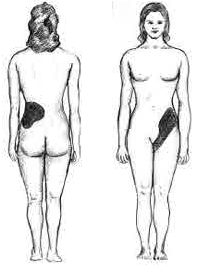Renal colic
| Renal colic | |
|---|---|
 | |
| Localization of pain caused by kidney stones | |
| Specialty | Urology |
| Complications | Acute kidney injury |
Renal colic, also known as ureteric colic, is a type of abdominal pain commonly caused by obstruction of ureter from dislodged kidney stones. The most frequent site of obstruction is the vesico-ureteric junction (VUJ), the narrowest point of the upper urinary tract. Acute obstruction and the resultant urinary stasis (disruption of urine flow) can distend the ureter (hydroureter) and cause a reflexive peristaltic smooth muscle spasm, which leads to a very intense visceral pain transmitted via the ureteric plexus.
Signs and symptoms
Renal colic typically begins in the flank and often radiates to below the ribs or the groin. It typically comes in waves due to ureteric peristalsis, but may be constant. It is often described as one of the most severe pains.[1]
Although this condition can be very painful, most ureteric stones under 5 mm size will eventually pass into the bladder without needing treatments, and cause no permanent physical damage. The experience is said to be traumatizing due to the severe pain, and the experience of passing blood and clots as well as pieces of stone. In most cases, people with renal colic are advised to drink more water to facilitate passing; in other instances, lithotripsy or endoscopic surgery may be needed. Preventive treatment can be instituted to minimize the likelihood of recurrence.[2]
Diagnosis
The diagnosis of renal colic is the same as the diagnosis for renal calculus and ureteric stones.[citation needed]
Differential diagnosis
A renal colic must be differentiated from the following conditions:[3]
- biliary colic and cholecystitis
- aortic and iliac aneurysms (in older patients with left-side pain, hypertension or atherosclerosis)
- interstitial: appendicitis, diverticulitis or peritonitis (in this case patients prefer to lie still rather than being restless[3])
- gynaecological: endometriosis, ovarian torsion and ectopic pregnancy
- testicular torsion
Treatment
Most small stones are passed spontaneously and only pain management is required. Above 5 mm (0.20 in) the rate of spontaneous stone passage decreases.[4] NSAIDs (non-steroidal anti-inflammatory drugs), such as diclofenac[5] or ibuprofen, and antispasmodics like butylscopolamine are used. Although morphine may be administered to assist with emergency pain management, it is often not recommended as morphine is addictive and raises ureteral pressure, worsening the condition. Vomiting is also considered an important adverse effect of opioids, mainly with pethidine.[6] Oral narcotic medications are also often used.[citation needed]
There is typically no antalgic position for the patient (lying down on the non-aching side and applying a hot bottle or towel to the area affected may help). Larger stones may require surgical intervention for their removal, such as shockwave lithotripsy, laser lithotripsy, ureteroscopy or percutaneous nephrolithotomy. Patients can also be treated with alpha blockers[7] in cases where the stone is located in the ureter.
A 2019 review found three cases of renal colic were hydronephrosis caused by malpositioned menstrual cups pressing on a ureter. When the cups were removed, the symptoms disappeared.[8]
References
- ^ Nephrolithiasis~Overview at eMedicine § Background.
- ^ "eMedicine - Nephrolithiasis: Acute Renal Colic: Article by Stephen W Leslie". Retrieved 2008-01-01.
- ^ a b "Managing patients with renal colic in primary care - BPJ 60 April 2014". bpac.org.nz. Retrieved 2019-01-26.
- ^ Ordon, Michael; Andonian, Sero; Blew, Brian; Schuler, Trevor; Chew, Ben; Pace, Kenneth T. (2015-01-01). "CUA Guideline: Management of ureteral calculi". Canadian Urological Association Journal. 9 (11–12): E837 – E851. doi:10.5489/cuaj.3483. ISSN 1911-6470. PMC 4707902. PMID 26788233.
- ^ Teece, DD (2006). "Intravenous NSAID's in the management of renal colic: Article by Debasis Das". Emergency Medicine Journal. 23 (3): 224–225. doi:10.1136/emj.2005.034330. PMC 2464448. PMID 16498166.
- ^ Holdgate, A; Pollock, T (18 April 2005). "Nonsteroidal anti-inflammatory drugs (NSAIDs) versus opioids for acute renal colic". The Cochrane Database of Systematic Reviews (2): CD004137. doi:10.1002/14651858.CD004137.pub3. PMC 6986698. PMID 15846699.
- ^ Lipkin, Michael; Shah, Ojas (2006-01-01). "The Use of Alpha-Blockers for the Treatment of Nephrolithiasis". Reviews in Urology. 8 (Suppl 4): S35 – S42. ISSN 1523-6161. PMC 1765041. PMID 17216000.
- ^ Eijk, Anna Maria van; Zulaika, Garazi; Lenchner, Madeline; Mason, Linda; Sivakami, Muthusamy; Nyothach, Elizabeth; Unger, Holger; Laserson, Kayla; Phillips-Howard, Penelope A. (2019-08-01). "Menstrual cup use, leakage, acceptability, safety, and availability: a systematic review and meta-analysis". The Lancet Public Health. 4 (8): e376 – e393. doi:10.1016/S2468-2667(19)30111-2. ISSN 2468-2667. PMC 6669309. PMID 31324419.